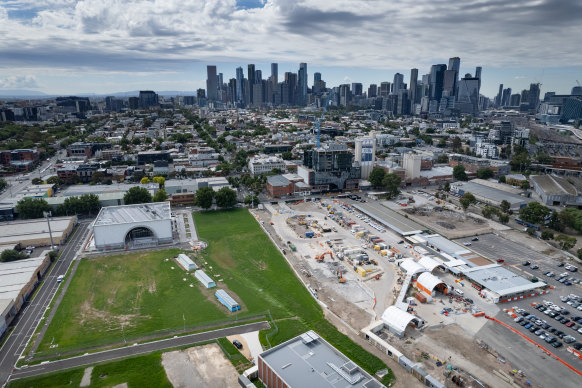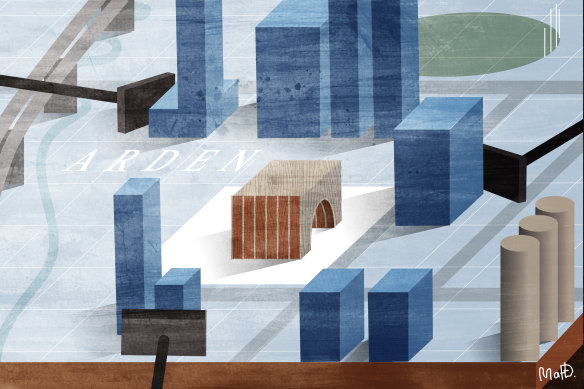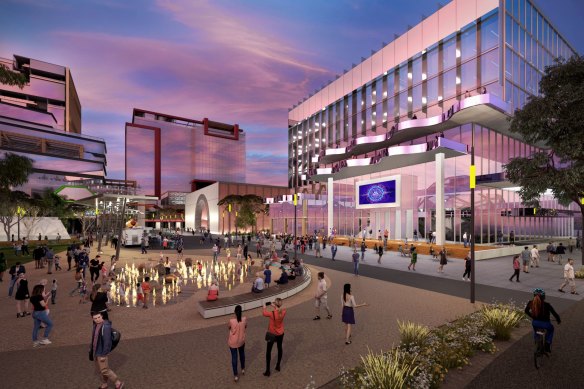This was published 1 year ago
Opinion
The pictures show happy citizens lolling about in a new nirvana. The reality will be a grey urban ghetto
Norman Day
ArchitectSometimes, it seems we go about land management and planning for Melbourne as if it were a battle plan.
In recent times, there has been Docklands, that grey lifeless concrete bunker by the Yarra River, and Fishermans Bend, which is stuttering into reality for want of a believable concept. The latest plan is focused on the Arden lands surrounding the new Metro station in North Melbourne.

The state government owns most of the land at Arden, where an ambitious urban renewal precinct will be located.Credit: Jason South
They all suffer the same fate – a lack of creative vision and an inability to deal with human scale and real-life issues.
For Arden, there were several well-meaning pre-planning documents made, including the 2022 structure plan. They appear to show options for land use, indicating a need for innovation and mixed use, meaning job creation and economic growth. The concept will include just 6 per cent of affordable housing, to provide neighbourhood “resilience” (meaning hanging onto the character and demography of what exists now).
The plan now is to transfer future actual development off to a single developer, who will make their own mark on spatial quality (or not).
Of course, the original 2022 report suggests the site will be developed sustainably. How is not specified, but it mentions it will contain, “world-leading building design”, and will be “cool and green”.
There will be urban design, which is not described, but noted as “measured by performance assessment”, whatever that means. However, the latest plans appear not to contain much allowance for useful public open spaces.
The report notes there will also be public streets, which is refreshing, and they will celebrate Aboriginal culture; just how is unspecified.
One of the hot topics of this war cabinet document is the “celebration of water”. Investigation shows that is a reference to flood mitigation from the adjacent Moonee Ponds Creek.
Not much of those strategies seem to survive in more recent documents issued by the Victorian Planning Authority this year. Their main battle plan shows a disappointing diagram for buildings to be located almost to cover the whole precinct. They range from 40 storeys high to three, and they fill the gaps between the small streets around Arden Station, like so many bomb sites in a military action plan.
The result will be like Docklands, maybe worse, with dark streets cutting through major blocks of construction, and an appearance of little useful public open spaces.
It is bound either to become a miserable, grey urban ghetto on completion, or alternatively, a site ripe for demolition and redesign after a brief existence.
It may be that the procurement process is at fault. Land-management planning (it is not urban design) allows for decisions based on satellite images, Google Maps at a scale of 1:1000 or more and working from remote distant locations – which tends to isolate the decision-makers from reality.
A problem, as in the military, is that the damage is done on the ground, where people live their lives and try to make something of their ill-conceived environment, and destruction follows.
Another contributing factor to the failures of this methodology is the selection of those who participate in its decision-making, including government agencies, politicians, municipal officers, lobbyists, financiers and investors, logicians and the implementors (suppliers of materials, labor, project and development managers).
This diverse group of uncreative experts usually gathers in a “war room” for a day or two to bash out a new plan for this or that development zone. They work hard to represent their interests, and decisions are mapped for the site in question, usually using something like coloured crayons on a large paper plan, or a white board, which is refreshed and updated during the process.
In the end, a coloured plan evolves to become the guide document for redevelopment – the battle plan.
(There’s a story about one of these “situation room” meetings held for Fishermans Bend, which may be apocryphal. The gathering was over, the agreed compromised plan uploaded on a wall, and the cleaners asked to tidy up after a busy couple of days. In the process, they discovered an unused pink crayon on the floor under a desk.

Credit: Matt Davidson
Problem is, the pink crayon was intended to be used to represent locations for community facilities on the site plan – things like schools, pre-schools, community and neighbourhood meeting rooms, resource centres, accessibility assistance services and basic health rooms. Whoops.)
Once these base diagrams are delivered, they are promoted into production. Plans and PR scripts are produced showing how cleverly the plan deals with various issues. Seductive, colourful pictures are released of happy citizens lolling about in a new nirvana.
Imagery is styled like those Little Golden Books of last century, showing either a happy sunny day in late spring, or a late summer evening, leaves on the trees, grass newly mowed, people strolling over hectares of empty open space, some in wheelchairs, bikes, prams of course, and doves flying overhead (no screeching cockatoos or swooping magpies in this world).
In the case of Arden, having a single developer will in effect novate any future design decisions to them. The pace of development, the vision, design details and decisions of community value and investment will be privatised.

An artist’s render of the future Arden precinct.Credit: Development Victoria
The problem with this land-management process is its point of reference. Successful urban renewal relies on working from the ground up, developing aspirational ideas for people on the ground that achieve their living needs, done using imagination to create a vision.
Once those stratagems are in place, with concepts supporting human interactions, the process is half done. Then, a creative urban design can occur, looking at the whole program across the precinct in ways that imbue it with delight, pleasure, comfort, usefulness and values that humans understand.
The sensible way to achieve that outcome is to have the design vision established along with developed details for building heights, materials, textures and relationships between built and open spaces, before attracting developers to assemble the projects.
Good urban design is a creative exercise, not battle planning.
Perhaps, those who desire a better result should adopt a version of the war cry of other concerned citizens for a different matter – Ban the Planning Bomb. Give Peace a Chance.
Norman Day is a practising architect, commentator, and educator.
The Opinion newsletter is a weekly wrap of views that will challenge, champion and inform your own. Sign up here.